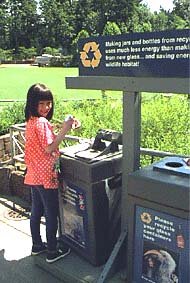 Water Conservation
Water Conservation
Water consumption is a very important and necessary for running the zoo but there are many ways that we can still make a difference. The new Steller Cove exhibit utilize closed filtration systems so they do not need to be dumped and refilled. The old zoo design often included pools that relied on fresh water running into them constantly to keep the water clean and give it a moving water effect. The new exhibits in the zoo have filters and pumps added to prevent daily water wastage.
Energy Efficiency
We have concentrated a lot of time on decreasing our energy usage in the last ten years and continue to feel this is important. Sub-meters have been installed throughout the zoo to determine where the consumption of water, natural gas and electricity is low and where it needs to improve. Timers and sensors have been installed in service areas and we switched to compact fluorescent lights to help in lowering our energy usage. We even used an ENACT grant this year to re-commission our most costly building in terms of energy costs.
Outreach
One of the big improvements in our environmental impact has been in the education of staff. We can have the best policies in the world but if they are too difficult to follow or if only a handful of staff knows what the policies are, it doesn't help the environment much. There are approximately 150 permanent employees at the zoo. Making sure everyone understands our policies and knows what things they can do to help us reach our environmental goals can have a great impact. We also do monthly articles in the staff and volunteer newsletters and quick updates at staff meetings to keep everyone informed of changes.
Recycling
One of the ways in which the staff and zoo visitors can help the environment is to make sure they recycle. There are several recycle stations on grounds for visitors and most work areas have there own recycle stations as well. Sure, we recycle paper, aluminum, glass, cardboard and some plastics but we also recycle construction waste, computer and copier cartridges, bubble wrap, yard debris and about 100,000 pounds of manure a month! We put about 65% of our paper back into the recycle loop.
Waste Reduction
The zoo is working very hard to improve our "paperless office” practices. We are trying to conduct more work using e-mail rather than using hard copies. Educating our vendors about wasteful packaging has effected our purchasing practices. We are even encouraging visitors to pack low waste lunches to help reduce the amount of refuse going to landfills. In addition, we took a 6-week period and monitored our incoming mail. For duplicate publications, we asked staff to determine if they need the extra copies or could manage with routing items instead. We also got removed from the mailing list of sources sent to staff no longer employed here.
Transportation
Most zoo employees have agreed to leave their cars at home one day a week or more. Many use public transportation, carpool, bike or walk to work and some can even telecommute. Staff and visitors alike are encouraged to use alternative transportation such as MAX Light Rail, which has a stop right at the zoo entrance.
We try to limit the amount of driving for zoo business as well. Most of the vehicles you see around grounds are small, lightweight and fuel-efficient. A few of our carts are electric powered as well.
Restaurant Operations
In Cascade Grill, we serve our visitors coffee that is 100% shade grown. This is important because trees used to shade some coffee plants provide habitat for many migratory birds. Their survival is impossible in areas where coffee is grown without shade. Also, we have switched to using reusable cups and reusable flatware in the Cascade Grill Restaurant to help reduce our solid waste and to reduce the need for plastic-ware and paper cups.
In addition, our chef at Cascade Grill has agreed to strive toward serving ecologically sustainable food products in the restaurant and for catered events.


